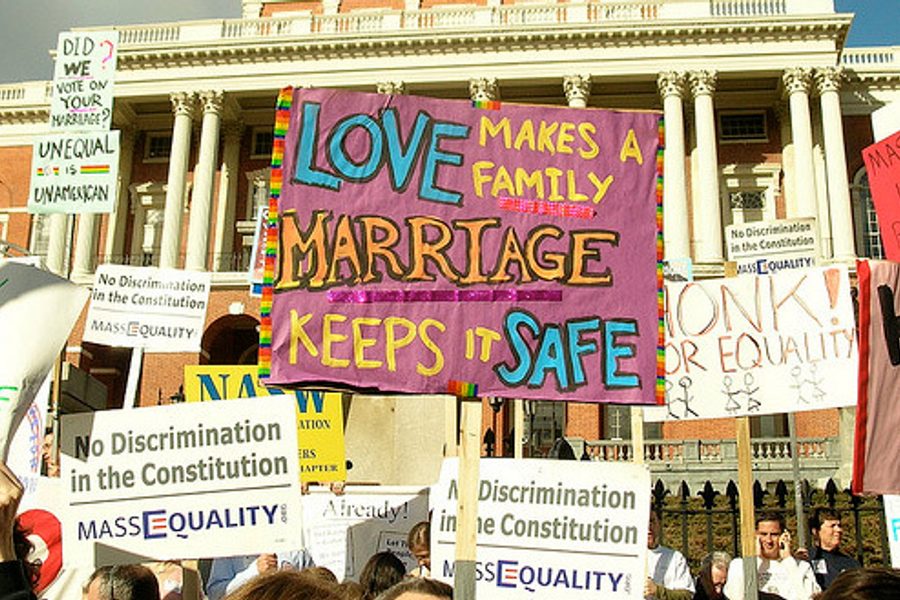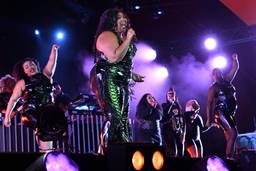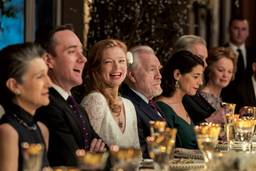The Same-Sex Marriage Trap
‘The Marrying Kind?’ dances around queer critiques of gay marriage.
Yasmin Nair

There’s a telling moment at the outset of The Marrying Kind?: Debating Same-Sex Marriage Within the Lesbian and Gay Movement, a recent book from the University of Minnesota Press whose stated aim is “to examine same-sex marriage debates within the LGBT movement.” We’re informed, in the acknowledgments, that Alice Taylor Houston, the late mother of one of the editors, Verta Taylor, “whispered shortly before she died that she believed that during their lifetime Verta and Leila [Taylor’s partner] would have a chance to marry.”
It’s not that such a deeply personal story shouldn’t have been related at all. But here, the anecdote serves to forestall any real criticism of gay marriage in the political landscape, as if to say, Go ahead — deny the wishes of someone’s dead mother. We dare you. The acknowledgements section ends with a nod to “the activists around the country … who believe that the freedom to marry must prevail over fear and discrimination and whose stories we tell here during an extraordinary moment in the history of marriage in the United States.”
If I’m dwelling on the acknowledgments section, it’s because it forecasts, unfortunately, the lie that pervades the book. While the question mark in the title of The Marrying Kind? suggests that a debate is to be found in its pages, the book’s editors and nearly all of its contributors seem determined to convince us that the answer to the question posed in the book’s title is a decided yes. While it’s true that certain queer critiques of gay marriage are presented in the book, in essay after essay we’re informed as to why these arguments are in fact misguided, making these critiques little more than straw men. Disappointingly, The Marrying Kind? shows that the mainstream gay community has heard the more radical critiques of gay marriage as a cause célèbre — and, instead of grappling with them, has put its energy into dressing gay marriage in radical trappings.
The book starts out well enough, with Arlene Stein’s case study of Newark, N.J. There, the fight for the right to marry isn’t simply off the radar of the city’s Black and Latino/a queer population, but actively works against the interests of people who have bigger issues to think about, including safety, joblessness, housing and a precarious economy. Stein contrasts Newark with the prosperous neighboring city of Maplewood, a suburban “queer enclave” whose mostly white gays and lesbians marry and adopt children from China or — in a reminder of the inequality between the two cities — from Newark’s poorer families. The tale of two cities shows the disconnect between the mainstream gay community’s investment in the idea that marriage will bring both psychological and economic benefits to gay people, and the reality that, as Stein writes, “It will benefit some queer people, diminish many of those who cannot and do not wish to marry, and have a negligible impact upon others. It is particularism masquerading as universalism.” Like many queer critics of gay marriage, Stein points to an alternative by which “a transformational queer politics would support the diversity of family structures,” including people who don’t marry at all, even when they are raising children.
Stein’s essay is sharp and incisive. Unfortunately, it is the only essay in the book that forthrightly critiques the gay marriage movement. Other queer critiques of gay marriage, including but by no means limited to those voiced since the early 1990s by queer theorists like Michael Warner and Lisa Duggan, are glossed over, defensively dismissed, or not represented at all in the book’s remaining 10 essays (most of which were written by sociologists).
That’s a pity, as queer critiques of gay marriage are as old as the marriage movement itself. Warner and Duggan are only two amongst a vast array of critics (full disclosure: including myself and the collective I helped to found, Against Equality). But only they and the San Francisco group Gay Shame get more than a passing nod in The Marrying Kind?.
Gay-marriage critics fall into several broad camps. For some, gay marriage is problematic because it represents assimilation, a veering away from the liberationist impulses of queer politics, which they mostly identify in terms of sexual freedom. For others, gay marriage represents the widening of the privatized, neoliberal state, where even lifesaving benefits like health care are now mostly available through marriage. Rather than fight for, say, universal access to healthcare — as queers did at the height of the AIDS crisis — gay marriage proponents argue that same-sex marriage is necessary because it allows access to such benefits, and in doing so, they naturalize the neoliberal state as a necessary one.
These arguments have been met with resistance by well-known gay mainstream groups such as Human Rights Campaign and the National Gay and Lesbian Task Force, which have always unashamedly acknowledged that they do in fact want to be seen as “normal” and want the legal benefits of marriage. But The Marrying Kind? represents a next generation of gay-marriage supporters, seemingly a more ambivalent lot, who ultimately seek to justify their stance not as a conservative but as a progressive one. These are more aligned with the likes of Dan Savage, whose position as a pro-gay marriage but fiercely kink-positive sex columnist (who also supports non-monogamy) allows straight progressives and leftists to voice their support for an institution they might otherwise abjure as a part of the capitalist scheme.
In that context, it’s only natural that such supporters might defend gay marriage from the critiques of Warner and others not on political and economic grounds, but with an insistence that gay marriage is in fact really, really transgressive. To that end, many of the essays in The Marrying Kind? try to prove, awkwardly, that those who engage in gay marriage are in fact completely anti-heteronormative, even outright subversive, and that their marriages are flipping the entire wedding cake upside down.
Katrina Kimport, for instance, sets out to show that lesbian wedding photographs, in their supposed recategorizing of gender performance, “disrupt normative assumptions about bodies and identity and … provide a complement to work that has insisted on the nondisruptive consequences of gay marriage.” Similarly, Melanie Heath looks at couples in Oklahoma who supposedly demonstrate “the transgressive potential of same-sex marriage.” She offers as examples the marriage of Oscar and Gary, who decided to remain non-monogamous even as they entered into a marriage contract, and the marriage of Don and Fernando, among the first gay couples to marry in San Francisco, whose “very public journey to marry offers a challenge to the ‘normality’ of marriage.”
What’s left unexamined is whether the simple presence of gay marriages in the public eye can in any way challenge what marriage is—rather than simply expand the idea of what marriage looks like. In its worn analyses, The Marrying Kind? refuses to grapple with the crucial fact that what makes marriage marriage is not the ceremonies or the images, or whether or not couples fuck only each other, but the way that marriage is still sutured to the state’s dispensation of vital benefits.There are suggestions here that the very specter of gay and lesbian and queer sex might trouble the normality of marriage, but surely no amount of fisting, fucking, fellatio, cunninglus or S/M — all of which are regularly and copiously engaged in by straight couples across the political spectrum, even if often covertly — actually shifts the meaning of marriage within the state itself. It might well be that Jane and Sarah and Dick and Robert are mocking or in some way subverting the conventional take on gender roles, but the fact remains that their unmarried friend Valerie will still be left to subsidize their lives together, that she’ll never be able to pass on her Social Security benefits to her best friend Kate, and that Kate, faced with a life-threatening injury, will never be allowed to avail herself of Val’s health care benefits unless she lies to the state and declares that the two are romantic partners. And as Stein’s outpost essay indicates, it’s an even more complicated picture if you’re poor, of color, and a single parent who depends on the state to subsidize childcare; being on welfare effectively means conceding to the regulation of your sexuality because every part of your life is scrutinized and measured by a watchful state which monitors you constantly.
By contrast, moderately well-off or relatively wealthy LGBT Americans like Dan Savage will never have to worry about the state policing their sexuality. And for the LGBT super-rich, gay marriage plays an active role in further privatizing and securing wealth by providing tax loopholes. The case of Edith Windsor, at the center of the Supreme Court’s Defense of Marriage Act decision, is symptomatic: Everywhere, gays and lesbians have celebrated Windsor’s win as one of their own when, in fact, what they’re celebrating is the right of wealthy gay couples to evade the estate tax through marriage — a right most couples, gay or straight, will never have the pleasure of exercising.
Katie Oliviero’s essay in The Marrying Kind?, “Yes on Proposition 8,” seems, at first glance, to support a critique of gay marriage’s role within neoliberalism, as Oliviero does note the problematic nature of conferring key benefits such as health care through marriage. But throughout the essay, Oliviero acknowledges this critique without engaging with it head-on, choosing instead to lump it in with another queer critique, that gay marriage represents the “assimilating [of] the diversity of nonnormative sexual desire into a rigid matrimonial form mimicking heterosexual conventions.” Ultimately, Oliviero concludes that “queer critiques of same-sex marriage overlook the fact that broadening the scope of civil recognition is necessary to satisfy the distinctly queer goals of supporting and celebrating a diverse array of sexual, caretaking, and living arrangements.” But simply recognizing a diversity of kinship structures does not end the larger project of privatization that the institution of marriage enables. And on that point, Oliviero offers little more than the sunny but unconvincing assertions that the gay marriage movement “highlight[s] the neoliberal state’s withdrawal from public welfare responsibilities” and that “by decentering the heterosexual nature of marriage, same-sex marriage is one step toward a broader social justice vision that democratizes access to key resources such as health care and social security beyond (gay or straight) nuptials.”
That’s a nice idea, but it’s hard to see how fighting for inclusion in the benefits-distribution system that is marriage will in any way challenge the legitimacy of that system rather than just reinforce it. Under the guise of social progressivism, gay marriage is the ultimate neoliberal shell game, a sleight of hand that obscures the real inequalities faced by those who won’t or can’t marry into economic stability or wealth. The Marrying Kind? should have held to the promise of the question mark in its title and allowed for a more combative debate. Instead, what we get is a pallid and repetitious collection of essays that seem aimed to fend off critiques the editors and contributors have no interest in engaging.
Yasmin Nair is a writer, academic, and activist. She’s an editor at large at Current Affairs, on the editorial board of the Anarchist Review of Books, co-founder of the radical queer editorial collective Against Equality and the (Volunteer) Policy Director of Gender JUST. She’s currently working on her book Strange Love: A History of Social Justice And Why It Needs To Die. Her writing can be found at www.yasminnair.com.








